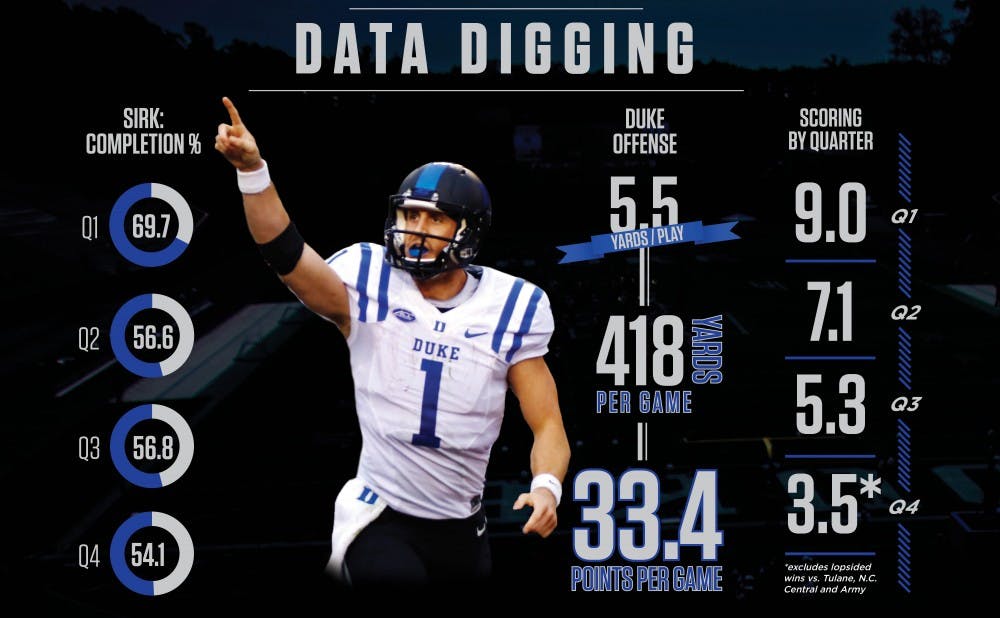The Blue Devils capped what might very well be a season-defining win Saturday with a gritty two-yard plunge from quarterback Thomas Sirk to beat Virginia Tech in quadruple overtime. The play before that, Sirk had lofted a perfect ball in between the cornerback and the safety that fell right into the hands of tight end Erich Schneider for a 25-yard game-tying score.
That sequence was, in many ways, a glimpse into what Duke’s offense could (or should?) look like if firing on all cylinders. Sirk’s mobility and toughness on the ground has always been a given, but for much of Saturday he showed the arm strength and downfield accuracy his receivers and coaches often rave about yet have been missing earlier this season.
Through seven games, the numbers cast a favorable light on the Blue Devil offense. Duke’s 33.4 points per game sits in the nation’s top 50, and a healthy 5.5 yards per play produces an average of more than 400 yards per contest. That seems to be a trio of positive offensive indicators, but dig a little deeper and those numbers appear skewed thanks to Duke’s first-quarter performances.
The Blue Devils have been at their best at the outset of games, scoring at least one first-quarter touchdown in five of their seven contests and kicking a field goal in the other two. Sirk has been particularly precise in the opening 15 minutes, compiling a 69.7 first-quarter completion rate—a significant jump from his 60.1 overall mark. Whether it be a great initial script from the coaching staff or the fact that the opposing defense has yet to make adjustments, Duke’s offense looks pretty good in the opening quarter.
From there, the offensive production drops off precipitously. The team’s average points scored per quarter declines from 9.0 in the first quarter to 7.1 in the second and 5.3 in the third. Although the Blue Devil ground game improves slightly as the game progresses—Duke’s yards per carry increase from 4.4 to 4.6 to 4.7—those gains are more than offset by a decrease in passing efficiency.
Sirk’s completion percentage in the second and third quarters of 56.7 is 13 points less than his first-quarter mark, and it’s hard to score points as an offense when the completion percentage is hovering below 60 percent, especially when most of those passes are of the underneath variety.
As for the all-important fourth quarter, this is where the numbers can be a little deceiving. The Blue Devils’ 63 fourth-quarter points are heavily padded by the soft underbelly of their nonconference schedule—Tulane, N.C. Central and Army, who have combined for just four wins against FBS teams. In the fourth quarters of these three blowout wins, Duke totaled 49 points and 391 yards.
Take out those three games, and suddenly Duke’s fourth-quarter offense averages 3.5 points per game with just a single touchdown. In the fourth quarters of non-blowout games, the Blue Devils have played the equivalent of an entire game and totaled just 14 points and 224 yards, with 4.3 yards per attempt by Sirk.
Now, back to Saturday’s win at Virginia Tech. The game almost perfectly replicated the trends described above—two early touchdowns in the first quarter as the offense looked primed for a breakout game, but then only 10 points in the last three quarters as the Hokies stormed back to force overtime.
Then in the overtime period, Duke scored on each of its four possessions and racked up 21 points. Of course, it is much easier to score when you start with the ball already in field-goal range, but the Blue Devils moved the ball inside the five-yard line on each of their final three possessions.
Maybe it was the high-stakes pressure of an overtime game, but offensive coordinator Scottie Montgomery became more aggressive with his play-calls—and that seemed to make a difference.
Thanks to a 60/40 pass/run split across the four overtime periods—compared to Duke’s overall 45/55 split and 39/61 fourth-quarter breakdown—the offense still picked up 6.2 yards per play despite playing with a short field where they could never gain more than 25 yards on a single play. Although he only attempted six passes, Sirk averaged 8.3 yards per throw, compared to his overall 6.7 average.
The Statistics department here might prohibit me from completing the major if I proclaim that a 10-play sample that occurred under very different circumstances than regulation play holds the key to unlocking the Blue Devils’ offense.
But, as Virginia Tech can attest to, you can’t really argue with the results.
Get The Chronicle straight to your inbox
Signup for our weekly newsletter. Cancel at any time.

